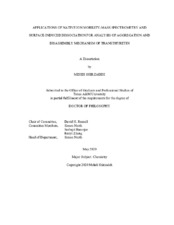| dc.contributor.advisor | Russell, David H | |
| dc.creator | Shirzadeh, Mehdi | |
| dc.date.accessioned | 2021-01-07T16:44:20Z | |
| dc.date.available | 2021-01-07T16:44:20Z | |
| dc.date.created | 2020-05 | |
| dc.date.issued | 2020-04-14 | |
| dc.date.submitted | May 2020 | |
| dc.identifier.uri | https://hdl.handle.net/1969.1/191865 | |
| dc.description.abstract | The proposed mechanism of fibril formation of transthyretin (TTR) involves self-assembly of partially unfolded monomers. However, the mechanism(s) of disassembly to monomer and potential intermediates involved in this process are not fully understood. In chapter 2, native mass spectrometry and surface-induced dissociation (SID) are used to investigate the TTR disassembly mechanism(s) and the effects of temperature and ionic strength on the kinetics of TTR complex formation. SID of hybrid tetramers, formed during subunit exchange, provide strong evidence for a two-step mechanism whereby the tetramer dissociates to dimers that then dissociate to monomers. Also, the SID results uncovered a hidden pathway in which a specific topology of the hybrid tetramer is directly produced by assembly of dimers in the early steps of TTR disassembly. Implementation of SID to dissect protein topology during subunit exchange provides unique opportunities to gain unparalleled insight into disassembly pathways.
Chapter 3 is focused on studying the consequences of a dual-FLAG (FT₂) tag on TTR structure and associated thermo-cleavage using collision-induced unfolding and variable-temperature electrospray ionization source. Our results indicate the increased stability of TTR with the tag (FT₂-TTR); however, a lysine cleavage at position 9 was observed only for FT₂-TTR at elevated temperatures (≥24 °C). Metal identity and concentration were found to be effective to modulate the cleavage and was correlated to the metalloprotease activity of TTR. This study further extends the application of native ion mobility-mass spectrometry (IM-MS) to assess structural modifications upon tag infusion during purification.
In chapter 4, a metal-induced oxidation pathway was observed leading to the N-terminal backbone fragmentation of TTR and oligomer formation. Home-built Fourier transform ion mobility Orbitrap MS and SID revealed previously hidden details of TTR oxidation which results in TTR unfolding. This study necessitates the careful analysis of biomolecules where metal/small molecules can tremendously impact on biological function and structure of proteins.
Lastly, in chapter 5, several modifications of original SID designs along with some potential improvements with implications of ion carpet and ion funnel are discussed. Improvement in transmission in the fly-through was obtained, however, signal enhancement for larger ions in collision mode requires further investigation. | en |
| dc.format.mimetype | application/pdf | |
| dc.language.iso | en | |
| dc.subject | Native ion mobility-mass spectrometry | en |
| dc.subject | Surface-induced dissociation | en |
| dc.subject | Transthyretin | en |
| dc.subject | stability | en |
| dc.subject | subunit exchange | en |
| dc.subject | topology | en |
| dc.subject | SID | en |
| dc.title | Applications of Native Ion Mobility-Mass Spectrometry and Surface-Induced Dissociation for Analysis of Aggregation and Disassembly Mechanism of Transthyretin | en |
| dc.type | Thesis | en |
| thesis.degree.department | Chemistry | en |
| thesis.degree.discipline | Chemistry | en |
| thesis.degree.grantor | Texas A&M University | en |
| thesis.degree.name | Doctor of Philosophy | en |
| thesis.degree.level | Doctoral | en |
| dc.contributor.committeeMember | North, Simon | |
| dc.contributor.committeeMember | Banerjee, Sarbajit | |
| dc.contributor.committeeMember | Zhang, Renyi | |
| dc.type.material | text | en |
| dc.date.updated | 2021-01-07T16:44:20Z | |
| local.etdauthor.orcid | 0000-0001-6306-9687 | |


